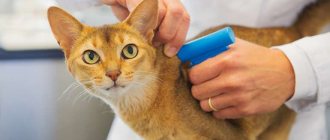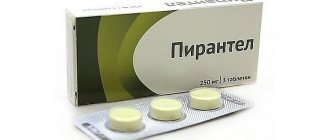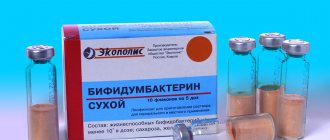Due to its versatility, the pharmaceutical drug “Levomekol” is actively used for cats. Many veterinarians give it preference, prescribing it to animals to heal wounds, suppuration and other damage to the epidermis. The correct use of the ointment is described in detail in the instructions, which you should definitely read before starting treatment.
Can it be used for bites, wounds and diseases?
Levomekol is a complex drug that is designed to accelerate the healing of wounds of various etiologies and effectively combat infections. Since the ointment has a water-soluble base, it easily penetrates the tissues and promotes their rapid cleansing of purulent contents.
The drug is used to treat all types of infected wounds and other purulent processes - boils, burns, weeping ulcers, abrasions and cuts. Despite the fact that the drug was originally intended for humans, it is successfully used to eliminate infected wounds in cats, if the need arises.
Contraindications and possible side effects
The ointment should not be used to treat wounds in cats with hypersensitivity to its components. Since allergic reactions to the drug in the form of redness, rash and irritation are possible. If such symptoms occur, it is necessary to remove the napkin or swab with ointment and thoroughly rinse the affected area with water. Then you should show the cat to the doctor.
Usually there are no negative reactions after using the medication. Symptoms of overdose were not detected even after the animal licked Levomekol several times. But it is better to avoid this, as there is a risk of allergies.
There are no restrictions on the use of ointment for kittens, pregnant and lactating cats. But if desired, the pet owner can consult a veterinarian.
Levomekol should not be combined with other products for external use that have a similar principle of action.
It is forbidden to violate the regime of application of the ointment, otherwise its therapeutic effect will decrease. If one procedure is missed, the next one is carried out as soon as possible, and then according to the schedule.
Composition and storage conditions
The effectiveness of the drug is due to its active ingredients, including:
- Levomycetin is an antibacterial component with proven effectiveness in practice. It has a destructive effect on most pathogenic microorganisms. Resistance to it develops slowly, so it can be used for long-term treatment of wounds, burns, and cuts.
- Methyluracil is a wound-healing component of Levomekol. Thanks to this substance, metabolic processes in tissues are stimulated and their regeneration is accelerated.
The shelf life of the drug is 3.5 years from the date of release.
The medicine should be stored in a dark place at a temperature not exceeding +20°C, out of reach of children and animals.
Precautionary measures
When working with Levomecol ointment, it is important to follow general hygiene and safety rules. So, when using a medical product, you should avoid its penetration into the mouth and eyes of both yourself and the cat. After the procedure, you should thoroughly wash your hands with soap and running warm water. Antibacterial cream is applied directly to the affected areas, avoiding contact with healthy skin. It is strictly contraindicated to swallow the medicine; if this cannot be avoided, you should urgently go to a medical facility. After the expiration date, Levomekol must be disposed of and cannot be used further.
How to smear?
The ointment is intended for external use. Veterinarians recommend soaking a small gauze pad or cotton swab with the drug, applying it to the wound and covering it with a loose bandage so that the cat can move freely. Dressings need to be done every day.
If the wound is small, you can simply lubricate it with ointment, applying a thin layer of the substance 1-2 times a day. It is important to ensure that the animal does not lick the drug, otherwise the effectiveness of the treatment will be reduced.
If it is necessary to place the ointment into the resulting cavity, it is recommended to warm it up to body temperature, and then inject it into the purulent pocket using a catheter or a sterile syringe of the required volume.
The product must be used if the cat is injured, the wound does not heal for a long time, and purulent contents accumulate in it. The ointment should be used until the injury site is completely healed. Depending on the severity of the disease, treatment may take up to 10 days. The decision to discontinue the drug must be made by the veterinarian.
Indications for use
Levomekol is prescribed to cats in the following cases:
- cat scratches and abrasions;
- open wounds (including purulent ones);
- sutures after surgery.
Levomekol helps eliminate purulent foci (for example, wounds or fistulas). It is used to prevent infection of damaged tissues (including after surgery).
The main component of the drug is effective against staphylococci, streptococci, diplococci, salmonella, proteus, escherichia and pasteurella. It helps destroy gram-negative anaerobic bacteria. Levomycetin is active against pathogens that are resistant to antibiotics from the group of penicillins, tetracyclines and sulfonamides, drugs based on streptomycin.
Levomekol is less effective against acid-fast bacteria and clostridia, as well as protozoa.
Levomekol is often used for lichen in cats as part of complex therapy (with antimicrobial and antiparasitic agents). However, treatment with ointment should be carried out after diagnosis and identification of the pathogen. After all, outwardly, lichen resembles a skin lesion that is caused by the activity of mites during demodicosis. And with the latter pathology, the ointment is ineffective. To avoid ineffective therapy, you must first clarify the diagnosis.
Interesting! Levomekol will not help cure shingles in cats.
The ointment can help cats with otitis media (diagnosed by a doctor). It is used independently at the initial stage of pathology. And for purulent inflammation, the medicine is used as part of complex therapy.
Interesting! For otodectosis, Levomekol is ineffective.
What to do if it licks it off?
In some cases, cats try to lick the ointment after application. Then experts recommend applying a bandage over the wound. But so that the animal is not constrained in its movements.
For a small pet, after applying the ointment, you can put a cotton sock with a cut-off toe on the body. Then the animal will not have access to the sore spot.
If your pet is calm, it is recommended to attach a special collar to its neck, which will not interfere with drinking and eating. You can make it yourself from thick paper or cardboard.
Operating principle
Levomycetin is the main antibacterial component of the drug. It binds to bacterial ribosomes and disrupts protein synthesis in microbial cells. Without a food source, they stop reproducing and growing, and subsequently die.
Methyluracil normalizes the exchange of nucleic acids and accelerates tissue healing in the wound at the cellular level. Under its influence, granulation tissue matures faster and the defect is covered with an epithelial cover. This component stimulates cellular and humoral immunity and stops the inflammatory process.
Levomekol provides decent wound care. The drug quickly relieves inflammation, destroys pathogenic microorganisms and accelerates healing.
After application, the ointment is quickly absorbed into soft tissues. Its components penetrate inside but do not damage biological membranes.
Interesting! The peculiarity of Levomekol is that its effectiveness against pathogenic microorganisms is maintained even in the presence of pus and areas of necrosis (tissue death).
Side effects
Despite the benefits, in some cases the drug can cause side effects.
First of all, the cat may have an allergic reaction. The animal begins to sneeze, scratch the surface of its skin, and become restless. Therefore, immediately after starting treatment, it is necessary to monitor your pet. If an allergy occurs, the ointment should be removed with a damp cotton swab and consult a veterinarian for advice.
If the ointment gets into the cat's stomach, in rare cases, digestive system upset may occur. Therefore, it is necessary to ensure that the pet does not lick the medicine from the application site.
However, if diarrhea begins, you should give the animal ¼ of a Levomycetin tablet and provide enough fluid to avoid dehydration.
Instructions for use
The medication is intended exclusively for superficial treatment of the dermis and is best used as prescribed by a qualified specialist - a veterinarian, who will make an accurate diagnosis, especially if lichen is suspected, and will prescribe the frequency of procedures. Typically, cats are treated with Levomekol over the entire surface of the damaged skin, repeating the procedure 1-2 times a day until complete recovery, but not longer than 10 days in a row.
If it is necessary to treat purulent cavities with medicine, then soak gauze pieces with the ointment and blot the wounds with it. Healing wound surfaces are treated with a thin layer, without covering the top with a bandage. When using “Levomekol” in the fight against lichen in cats, you should understand that they alone will not be able to cure the skin disease; the drug can only temporarily eliminate the manifestations of the rash.
Limitations and negative effects
The medication has virtually no contraindications for use. The only thing is that “Levomekol” is not prescribed to cats that have a personal intolerance to the components included in the antibacterial ointment. The medicine does not provoke negative effects, with the exception of manifestations of an allergic reaction. Veterinarians emphasize that if the cat’s rash, itching, or redness of the skin intensifies, it is necessary to stop treatment with Levomekol and consult a veterinarian. There have been no cases of overdose of the pharmaceutical product in question.
Advantages of the drug
The product has an antibacterial effect and effectively fights pathogenic microorganisms.
Most veterinarians prefer Levomekol ointment and prescribe it for the treatment of various skin problems in cats, since it has a number of positive qualities:
- quickly reduces the activity of pathogenic microorganisms living in purulent foci;
- has a detrimental effect on both gram+ and gram-bacteria;
- reduces fluid secretion from wounds;
- regenerates wound surfaces;
- fights inflammation, reducing swelling around wounds.
The main advantage of Levomekol is the absence of contraindications and excellent tolerability by cats.
Reviews about the treatment
Alexander, 38 years old, Vladivostok: “Our family has long had a large cat who loves walks in the fresh air. Several times she returned home with lacerations that festered and took a long time to heal. A veterinarian I know advised me to use Levomekol to speed up healing.
Our pet resisted for several days, but then she got used to the procedures. The wounds began to heal much faster. Now this ointment is always in the home medicine cabinet.”
Marina, 58 years old, Murmansk: “We gave our grandchildren a purebred cat for a holiday, and he accidentally got hurt. The wound began to rot, and the pet became lethargic, ate poorly and refused to play.
The veterinarian at the clinic recommended lubricating the cut site with Levomekol and taught how to make dressings. The grandchildren took care of the pet themselves. After a few days, the wound healed, and the cat became active and playful.”
Andrey, 45 years old, veterinarian, Sverdlovsk: “Cats, even domestic cats, often receive various injuries. I believe that the best remedy for treating purulent wounds is Levomekol.
Thanks to its good antibacterial properties, it quickly destroys pathogenic microflora. The cats are recovering quickly. Another advantage of this drug is its low cost.”
Why is it needed?
For wound healing, it is recommended to use Levomekol ointment, which is also used after surgery.
Levomekol is usually prescribed for cats to heal scratches, wounds, fistulas, as well as after surgical interventions in order to prevent the “activation” of staphylococci that live on the animal’s body. The drug is also prescribed for cats for various suppurations, to speed up the healing of sutures after operations and in the initial stages of otitis media. But most often, veterinarians prescribe ointment for cats against lichen.










